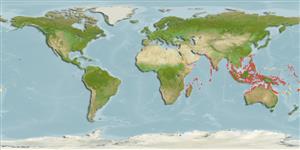>
Blenniiformes (Blennies) >
Blenniidae (Combtooth blennies) > Blenniinae
Etymology: Petroscirtes: Latin, petra, -ae = stone + Greek, skirteo = to jump.
Environment: milieu / climate zone / depth range / distribution range
Ökologie
seewasser riff-verbunden; tiefenbereich 1 - 10 m (Ref. 86942). Tropical; 25°N - 24°S
Indo-West Pacific: Sri Lanka to Fiji, north to southern Taiwan and the Yaeyama Islands, south to the southern Great Barrier Reef.
Size / Gewicht / Alter
Maturity: Lm ? range ? - ? cm
Max length : 15.0 cm TL Männchen/unbestimmt; (Ref. 9710)
Rückenflossenstacheln (insgesamt): 10 - 11; Rückenflossenweichstrahlen (insgesamt): 16-19; Afterflossenstacheln 2; Afterflossenweichstrahlen: 16 - 19. Sexually dimorphic: males are orange-brown while females are sea-green dorsally and lighter below. Similar to P. breviceps in shape but has a blotched, rather than lined pattern on the body. Some color form are probably habitat related. The plain form is mainly green and has numerous tiny pearly spots and occurs in seagrass beds (Ref. 48636).
Adults occur in seagrass beds of shallow lagoons. Also in Sargassum rafts during or immediately after wet season (Ref. 48636). Replaced by P. thepassi at Solomon Islands (Ref. 90102). They feed primarily on small crustaceans and occasionally on scales from fishes. Oviparous. Eggs are demersal and adhesive (Ref. 205), and are attached to the substrate via a filamentous, adhesive pad or pedestal (Ref. 94114). Larvae are planktonic, often found in shallow, coastal waters (Ref. 94114). This form was named by Bleeker (1852) as Petroscirtes bankanensis.
Life cycle and mating behavior
Geschlechtsreife | Fortpflanzung | Ablaichen | Eier | Fecundity | Larven
Oviparous, distinct pairing (Ref. 205).
Myers, R.F., 1991. Micronesian reef fishes. Second Ed. Coral Graphics, Barrigada, Guam. 298 p. (Ref. 1602)
IUCN Rote Liste Status (Ref. 130435)
Bedrohung für Menschen
Harmless
Nutzung durch Menschen
Mehr Information
ReferenzenAquakulturAquakultur ProfilZuchtlinienGenetikElectrophoresesVererbbarkeitKrankheitenVerarbeitungNutrientsMass conversion
PartnerBilderStamps, Coins Misc.LauteCiguateraGeschwindigkeitSchwimmstilKiemenoberflächeOtolithsGehirngrößeSehfähigkeit
Tools
Zusatzinformationen
Download XML
Internet Quellen
Estimates based on models
Preferred temperature (Ref.
123201): 26 - 29.3, mean 28.6 °C (based on 2654 cells).
Phylogenetic diversity index (Ref.
82804): PD
50 = 0.5005 [Uniqueness, from 0.5 = low to 2.0 = high].
Bayesian length-weight: a=0.00562 (0.00258 - 0.01228), b=3.06 (2.87 - 3.25), in cm total length, based on LWR estimates for this (Sub)family-body shape (Ref.
93245).
Trophic level (Ref.
69278): 3.1 ±0.43 se; based on food items.
Widerstandsfähigkeit (Ref.
120179): hoch, Verdopplung der Population dauert weniger als 15 Monate. (Preliminary K or Fecundity.).
Fishing Vulnerability (Ref.
59153): Low vulnerability (10 of 100).
Nutrients (Ref.
124155): Calcium = 113 [58, 171] mg/100g; Iron = 0.683 [0.413, 1.114] mg/100g; Protein = 18.4 [17.3, 19.4] %; Omega3 = 0.085 [0.048, 0.146] g/100g; Selenium = 21.3 [10.7, 42.6] μg/100g; VitaminA = 124 [40, 369] μg/100g; Zinc = 1.83 [1.25, 2.56] mg/100g (wet weight);
